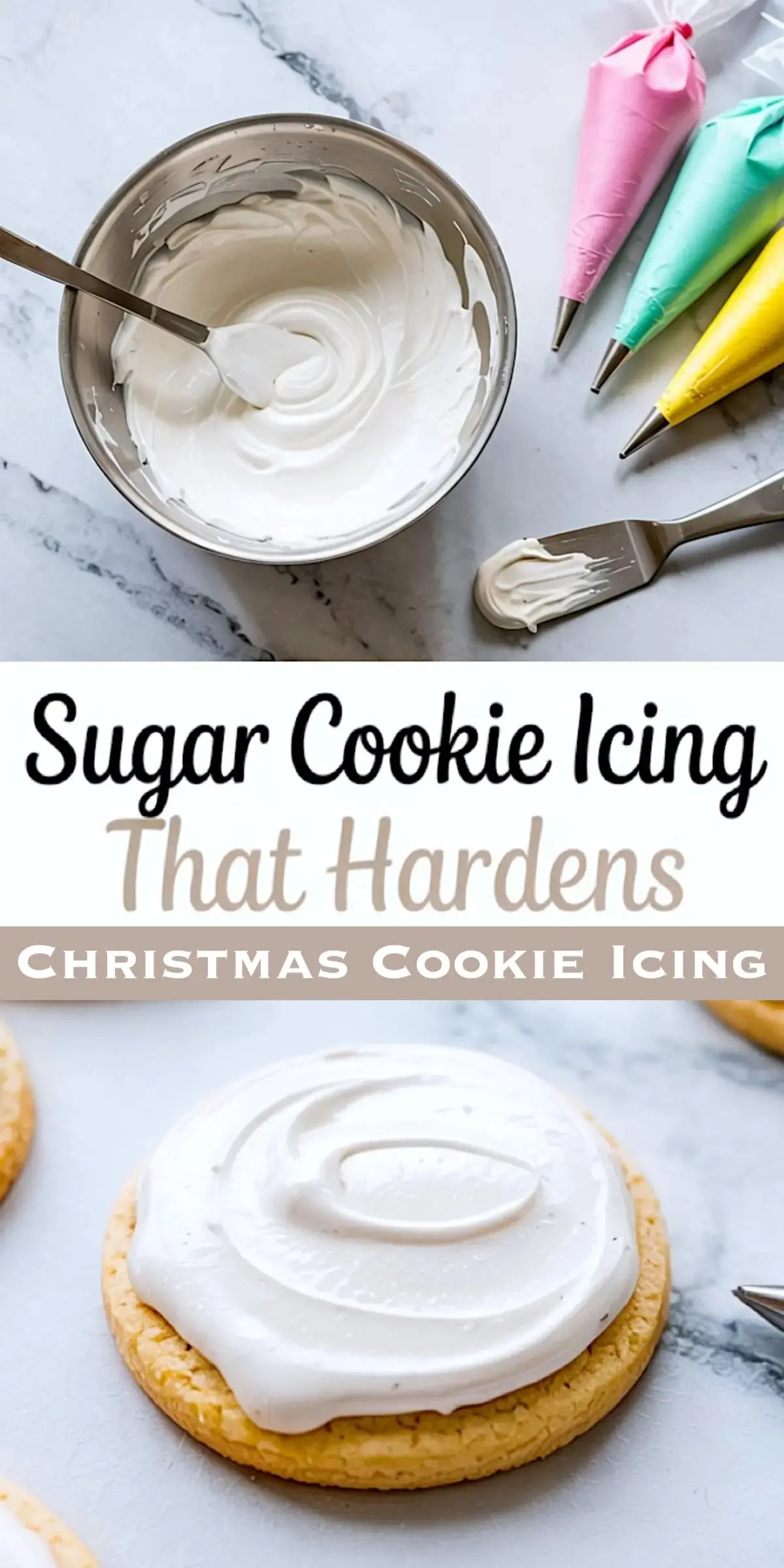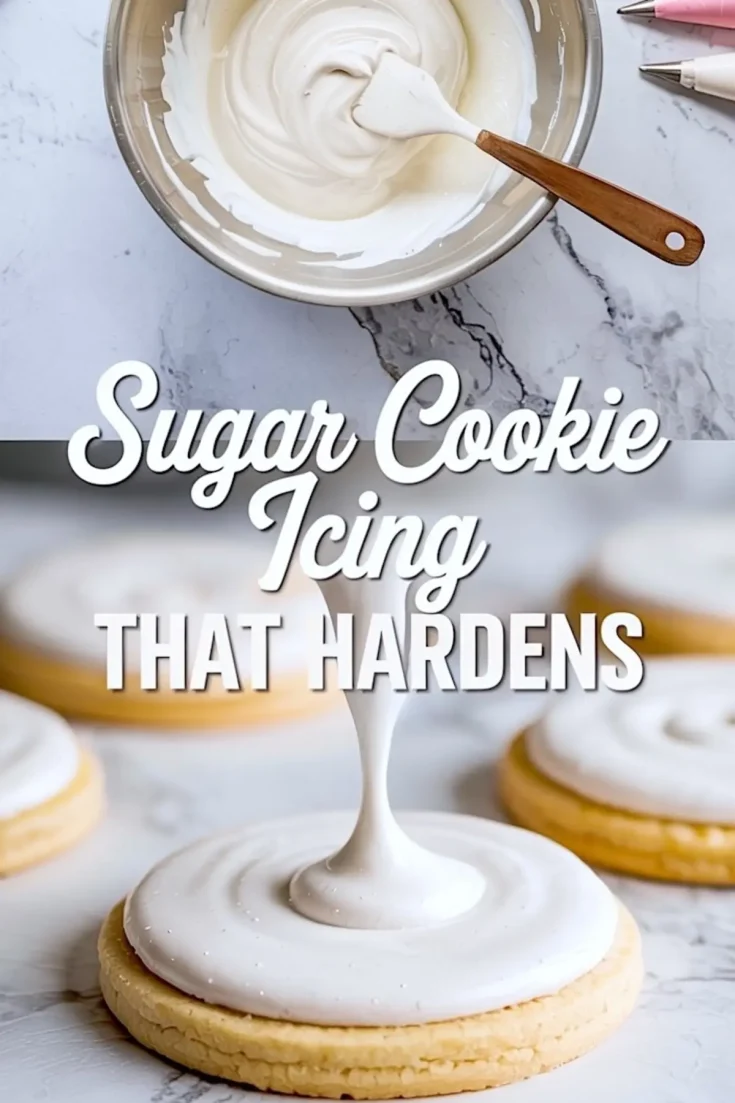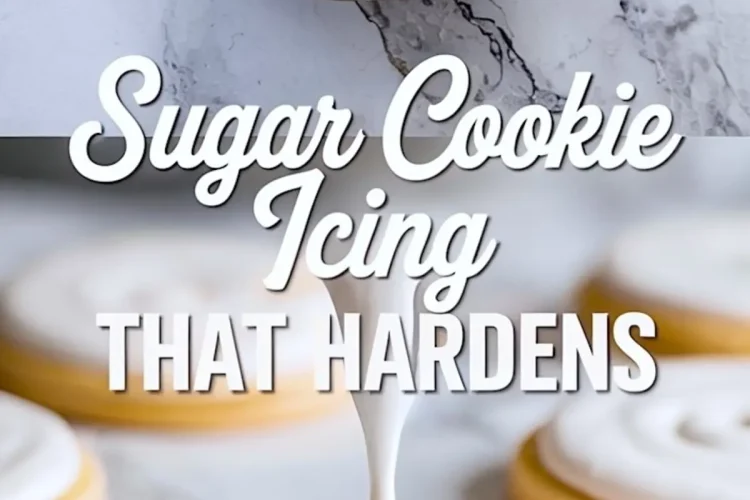Sugar cookie icing that hardens is the secret behind bakery-style cookies that look clean, stack neatly, and ship without smudging.
This icing recipe sets with a glossy surface and firm bite, so you can package your cookies with confidence. You’ll learn how to get the right consistency, how to color it without dulling the shine, and how to keep your decorated cookies fresh. With the right approach, you’ll see that icing that hardens isn’t complicated. It’s simple ingredients working together with a little patience.
Many readers look for the best sugar cookie icing or an easy icing recipe they can trust for the holidays. This version answers that need directly. It makes Christmas cookie frosting that hardens without being brittle, and it delivers consistent results whether you flood cut-outs or pipe fine details.

Why These Ingredients Work for Sugar Cookie Icing
Powdered sugar forms the structure. I always sift it first because lumps ruin the smooth finish. The difference between icing with sifted sugar and icing made without that step is night and day. The smoothness shows on every cookie.
Milk adds fluidity. It thins the powdered sugar into something workable. I’ve tested cream too, but milk keeps the icing light and dries more evenly. A thicker dairy slows drying time, which sometimes leaves the surface sticky.
Corn syrup is the quiet star. Just a spoonful gives shine and a little elasticity. That shine makes decorated cookies look polished, and the syrup helps prevent cracks as the icing sets. For holiday trays, I rely on this addition every time.
Vanilla extract is where you can make a choice. Clear vanilla keeps the icing white, which is useful for snowy cookies or bright colors. Classic vanilla darkens slightly, but it adds a warmer flavor. In my notes, I’ve found that if you want the cleanest background for food coloring, clear vanilla is best. For taste alone, I reach for the real extract.
A Quick Comparison That Helps You Decide
I’ve tried both clear vanilla and pure vanilla in this icing recipe. Clear vanilla gives you that bright white icing that looks like snow. It’s perfect if you plan to make bold reds or deep blues, because the colors stay true. Pure vanilla, on the other hand, gives a golden tint. That tint softens the look, which I find beautiful on cookies with pastel shades. Both work well, so choose based on the final design you imagine.
Mixing and Adjusting Consistency
Sifting powdered sugar may feel like an extra step, but it pays off once you stir in the milk and corn syrup. The icing turns silky, and you’ll notice how easily it blends without lumps.
Consistency is the part most bakers struggle with. If the icing feels too thick, add milk one teaspoon at a time. If it runs, add more sifted sugar. I’ve learned to test it by dragging a spoon through the bowl. If the line disappears in about ten seconds, it’s right for flooding. If the line holds longer, it’s good for piping edges. That little trick saves time and avoids over-correcting.
For another option in decorating, you can keep a batch slightly thicker and use it with this sugar cookie frosting recipe that spreads rather than sets hard. It depends on how you want to present your cookies.
Coloring the Icing Without Losing Shine
Gel food coloring is the choice here. Liquid food coloring adds too much moisture and thins the icing past the right point. Gel keeps the colors vibrant without changing consistency.
I divide the icing into small bowls and tint each one gradually. A toothpick works better than a spoon for measuring gel, since a little goes a long way. If you want a true white icing to pair with bright shades, use clear vanilla from the start.
When I decorated cookies for a cookie swap last winter, I tried both gel and powdered color. Gel gave the smooth finish. Powdered made the icing grainy. That little experiment reminded me why I stick with gel.
Decorating Cookies That Hold Their Shape
Once the icing is mixed and colored, it can be piped, flooded, or spread with an offset spatula. Each method leaves a slightly different surface. Piped edges look defined, flooded cookies look polished, and spread icing feels more homemade.
If you want variety on a cookie platter, mix these methods. I like to pipe an outline, flood the center, then sprinkle a few accents. This gives dimension without needing complicated tools. For holiday trays, I often decorate alongside a pan of Christmas sugar cookie bars to balance textures.
Drying and Storing Sugar Cookie Icing
This icing dries at room temperature in about 8 to 12 hours. Don’t cover or refrigerate the cookies during that time, because moisture slows down the setting. Once dry, the cookies can be stacked in layers with parchment between them.
Storage works best in airtight containers. They keep the cookies crisp and the icing glossy. I’ve mailed decorated cookies across the country using this icing, and they arrived without smudges. That’s why this recipe stays on my holiday list.
Any leftover icing can be sealed in a small jar and chilled for up to three days. Stir it well before using again. If it thickens in the fridge, add a drop of milk and stir until smooth. I often save small portions to drizzle over sugar cookie fudge.
Serving Ideas That Make It Festive
These cookies look striking on a Christmas table, but they also work year-round. Shape them into hearts for Valentine’s Day, stars for birthdays, or simple rounds with sprinkles for everyday treats.
For parties, I sometimes serve them alongside sugar cookie dip. The dip feels playful next to the polished cookies, and guests always like the contrast. That mix of casual and polished works beautifully on dessert tables.
Share Your Cookies and Save This Recipe

Sugar cookie icing that hardens gives you confidence when decorating. The glossy finish looks professional, and the firm set makes cookies easy to share.
Save this recipe to your Pinterest board so it’s ready for your next holiday bake. And if you try it, tell me in the comments how your cookies turned out, or if you found a favorite variation. Every baker brings a different touch, and I’d love to hear yours.
Sugar Cookie Icing That Hardens

Sugar cookie icing that hardens gives a smooth, glossy finish that sets firm for stacking, packaging, or gifting. I mix powdered sugar with milk and a touch of corn syrup to get the right shine and consistency. This sugar cookie icing recipe that hardens dries quickly without cracking and works well for piping or flooding. It’s my go-to for Christmas cookie icing that needs to look clean and stay put. Whether you’re icing classic cut-outs or need cookie icing that hardens for detailed designs, this version delivers every time. It’s simple to color, easy to mix, and makes the best sugar cookie icing for decorating in batches. Keep it in your list of cookie icing recipes that work for the holidays.
Ingredients
- 2 cups powdered sugar, sifted
- 2 tablespoons milk, plus more as needed
- 2 tablespoons light corn syrup
- 1/2 teaspoon vanilla extract (or clear vanilla for a pure white icing)
- Gel food coloring, optional
Instructions
- SIFT THE POWDERED SUGAR: Place the powdered sugar in a large mixing bowl and sift to remove any lumps. This ensures a smooth, clump-free icing base.
- ADD LIQUID INGREDIENTS: Pour in the milk and corn syrup. Stir slowly with a spoon or rubber spatula until the mixture starts to come together.
- STIR IN VANILLA EXTRACT: Add the vanilla and mix until fully incorporated. Use clear vanilla if you want the icing to remain bright white.
- ADJUST CONSISTENCY: Check the texture—it should be thick but still pourable. Add more milk 1 teaspoon at a time to thin it out, or add sifted powdered sugar 1 tablespoon at a time to thicken it.
- COLOR THE ICING: If using multiple colors, divide the icing into separate bowls. Add a small amount of gel food coloring to each and stir until evenly blended.
- DECORATE COOKIES: Transfer the icing to piping bags fitted with decorating tips for detailed work, or use a spoon or offset spatula for spreading and flooding.
- DRY THE COOKIES: Let the decorated cookies air-dry uncovered at room temperature for 8 to 12 hours, or overnight. Avoid refrigeration during this time, as moisture will prevent the icing from setting.
Notes
Store unused icing in an airtight container in the refrigerator for up to 3 days. Stir well before reusing. For layering designs, allow each layer to dry completely before adding the next.


I would like to know how this frosting taste. It’s all well and good to have a beautiful looking cookie, but I’d like to know how this frosting actually tastes?
The taste is mild and sweet, almost like a vanilla glaze. It lets the cookie flavor shine through, which is why I reach for it when I want a clean finish without a heavy frosting. I’ve used it on batches for gifting and it never feels overly sugary to me. 😊
I have been decorating cookies for years using royal icing. You instructions are the best I have ever seen and that includes haven taken a cookie bouquet class!
Cynthia, hearing that from someone with years of royal icing experience carries real weight. I appreciate it deeply. I remember walking into my first cookie class feeling completely lost, wondering how everyone made their lines look effortless. Over time I learned that clear steps make the whole process feel approachable, and that is the spirit I keep in mind when writing each guide.